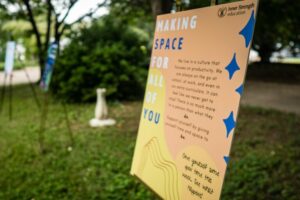Everyone can present themselves well in the right circumstances. The question is, when the human being is at rest, what is our essential nature? And how much does our conviction about our potential and inherent nature depend on those who touched us early on in life?
I teach a mindfulness class in a prison just south of town. It’s not a maximum security prison but there are plenty of guys in for life, for murder, and also plenty of innocent guys too, locked up to satisfy expediency without means or recourse to truth. Usually in this class, we just meditate. They are still and focused, and very kind in demeanor.
When we are quiet almost all of us can look like buddhas. A sheet of peace descends over our faces, softening the contours of our hardened angles, the watchfulness at the corners of our eyes. This says something about human nature and capacities. It also doesn’t necessarily say much about the beliefs we hold close, which define our lives.
This Saturday’s meditation was deep and still. Some of the guys are beginning to learn to allow the mechanical process of thought while gaining some space from each individual idea, belief, memory, regret, longing or fear. With the support of the stillness we create together, they dip into an aspect of themselves that is aware of their thought process but not affixed to it, an aspect of their experience that moves as the current of life, animated by sensitivity and care.
One of the men, who is usually quite quiet but who watches everything—every move, every nuance, every laugh—has been contributing more. Super knowledgeable, he’s read everything from Steven Pinker’s Better Angels of Our Nature to scientific studies on function of serotonin in the brain. He knows legal definitions and can explain the subtleties of Vedantic, Buddhist, and Taoist’s views on the universality of the human experience and a continuum of consciousness. I like him a lot, he’s a thinker. He’s also very buff and carries himself like a martial artist ever ready to spring.
As usual, after a long meditation, I asked how it went. This time my friend spoke up, he wanted to understand, “How do you let go when it’s not safe to be off guard?” A good question in this environment. During the stillness in the meditation, I had felt a powerful current pulling everyone deep. I wasn’t surprised that he, so in tune, had felt the anchor within. How do you let go, allow yourself to be undefended, off guard when the environment is not conducive?
The prison Activities Director explained, “In a prison anything can happen at any time. I was in the service, and I’m always watching over my shoulder.”
Though they’d never know it, I had my own images in my head. When I lived in India in the early 1980s, trekking in the mountains and visiting retreat centers, it was a rough and wild world. Drug smugglers and low-level weapons dealers from Afghanistan and Iran mixed with shoestring travelers, seekers, and hippies in the cheap hotels of Delhi and Bombay. Anything could happen at anytime, and sometimes did. Knife fight turf battles, down-and-out backpacker turned prostitute, identity falsification… I kept myself safe by attuning to my own sixth sense, on guard for pickpockets and pimps, cups of tea that might lead to frightening alleyways, shady characters with their thick veneer of charm and smiles. All of us looked so scruffy living the backpacker’s life, as we attuned to the austerities of the monasteries and mountains, it wasn’t always the external accouterments that told the most or the truest. It was the vibe, the undercurrent that gave directives that could not be overlooked. I didn’t tell my guys in the prison about those times, though I considered it. So they continued to try to educate my 50-something, sheltered-looking self. They wanted to let me into their lives and our session became an animated discussion.
“The only time guys can let their guard down,” one said to me, “is in our class together. On the block, there’s never quiet and never rest because anyone can come up behind you, test you, clock you on the head.”
Meditation is not naïveté. Through repeated practice, we cultivate awareness, we develop sensitivity not fear. We learn to recognize our surroundings, what we can trust, what’s appropriate in any given circumstance. Immersing in stillness is a time when we can, for a brief respite, let down our state of high alert and refresh our entire system—physical and psychological. If we’re always on high alert it skews up our neurological patterns and ultimately affects our brain and body health. Always at a heightened state, we react before thought and never return to normal or baseline. Extended periods of high stress etch patterns of hyper-alertness, which can mimic or lead to attention deficit disorder and other symptoms of anxiety or trauma. In meditation our body gets a reset.
So how do we, whether we’re in challenging environments like these men or in our tension filled schools or offices or even families, let ourselves let go? This is a nuanced exploration and the answers depend on who we are, the beliefs we hold most closely, and what, ultimately, we are seeking to accomplish through our practice of being aware.
In addition to our relationship with the outer environment, there was another aspect of the experience of awareness I wanted to illuminate, a different challenge of exploring stillness that doesn’t depend on external circumstance. The thick silence of mindfulness can lead us to what feels like an edge. In the discovery of what feels like infinite continuity—the unbroken expanse of consciousness—our separate selves feel like we come to a brink, a clear and frightening end of the familiar, a demarcation line that separates safe terrain from the unmapped. Stillness and ease can take us beyond the constricting ways we define ourselves. It can slip our guard down to our knees. And that’s when the resistances and distractions arise.
Our thought process can fill up like a snow globe in an inflatable bounce house. Sitting through the swirl without sticking like a burr to the fabric of our self-sense is not easy. Often, before we notice we’re holding on, all of our rational reasons to not let go state their claim. If we can, or sometimes by surprise, slip past that point, we find ourselves merged in an infinite current of Love.
So I asked this fellow, was this part of what was going on?
He considered for a short minute, then sprung back like a rubber band to a comfortable place. I hadn’t been quite quick enough or skillful enough to get through the well worn grooves of mind, and for the next twenty minutes we wound up debating the pros and cons of nonviolence. As we dug into it, I became more aware of the awesome complexity and responsibility of working with individuals whose circumstances, role models, choices, or even unfair cultural biases land them behind bars. Tenacious belief systems backed up by harsh experience aren’t easily dislodged, nor is it simple to find a compelling enough metaphor to entice anyone to pause and consider afresh.
“Maybe the Tibetans wouldn’t have been overrun if they had fought.” He posited. “I read an article this week about an Asian woman, three armed guys broke into her house. She was a tiny thing and she came downstairs firing–she killed one and injured the other. They were all armed, they could have shot her but they ran. The Tibetans could have done that. Maybe the Chinese would have just turned around if they were caught off guard. Maybe they’d just have figured it wasn’t worth it.”
Given the facts I rather doubt the Chinese invasion of Tibet would have gone any differently, resistance or not. And it is my understanding that many villages did stage mostly futile resistance against a force that so vastly overpowered them. The position of non-violence is ultimately a profound inner position. In this class, we had a fiery but rather circular and pointless exchange about the will of the Chinese army intent on taking over the rich minerals and strategic location of Tibet, regardless of cost.
And then the belief behind his position popped out.
“Some people,” the inmate said, “are just wicked.”
“Wicked is an awfully strong word,” I said.
“My brother was wicked. I was the youngest, you’d think he’d take care of me – never. He’d steal the meat in my sandwich and leave me with the bread. My mom knew it. When she’d make a hoagie she’d make him split it and I’d pick. You’d think sometime he’d just give me the bigger piece. Nope. Never. He’d spend 10 minutes measuring and eyeing before he sawed the bread in two so there wouldn’t be a sliver of difference. People are wicked.”
He turned to the other guys, “There’s a guy here, you know him, he smiles at you real nice but I know underneath he’d lash you as quick as anything. I always watch guys like that for the real wickedness to come out. That’s what’s underneath.”
He stood up and paced to the front of the room gesticulating. “Think of a little baby, playing with a rattle all happy. Try to take it away from him and he cries. ‘Mine!’ See? Wicked!”
The other guys shook their heads gently in disagreement, smiling. Clearly, they’ve had this discussion with him before.
“I don’t believe by and large, people are wicked. There are some who are incorrigibly mean beyond the circumstances they find themselves in or their history but those are fewer. There’s a spectrum of human nature and of course we’re always reacting to the environment we’re in. I see a lot of goodness. That’s why we practice, to strengthen and cultivate our own capacity for kindness and compassion.” I countered. Most of the other men in the room agreed. But this inmate, the one with the deepest meditation practice and the most well read on philosophies of mind and the universal nature of cause and effect, the one with the most refined understanding of consciousness as distinct from the objects of mind, held fast to his beliefs about the darker hue of our fundamental human nature.
Mindfulness is a wonderful training. It can reveal powerful aspects of our potential and insights into the human experience of being alive. But rooting out and transforming our deep-seated beliefs about the nature of reality, for all but a rare few, takes much more than the experience of stillness beyond thought.
That’s where the hard work for each and every one of us comes in. That’s where cultivating compassion and understanding for self and other in order to allow for a new possibility, is paramount. Ultimately, that’s where the experience and extension of Love and kindness may do more than any technique to create ease and a sense of home.
Then we can finally let down our guard and be.
#mindfulness, #massincarceration, #prisonmindfulness
Amy Edelstein is the founder of Inner Strength Foundation, which teaches mindfulness & cultural development. For programming, see InnerStrengthFoundation.net or AmyEdelstein.com




